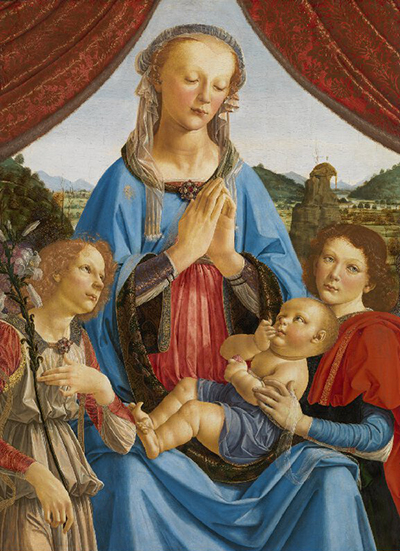The painting known as The Virgin and Child with Two Angels is a work of art by the Italian Renaissance painter Andrea del Verrocchio. It is on view in London's, National Gallery.
Andrea Del Verrocchio's painting dates between 1476 and 1478. His work uses the medium of tempera on wood panel. It measures 96.5 x 70.5 cm. With parted curtains at the top of the picture, the painting appears as a window on to the world. It shows the Virgin and Child in the middle with an angel on either side. The angel that appears on the left is holding a lily, a symbol of the Virgin's purity.
Verrocchio produced the picture in his workshop with the help of one of his students. Study and restoration work has made it possible to identify who worked on which parts of the painting. It's thought that Verrocchio painted the Virgin, the landscape plus the angel on the left. His student, Lorenzo di Credi was responsible for painting the Baby Jesus plus the angel on the right.
The painting offers several clues that point to there being two painters. Firstly, the detail in the turned-up toes of the baby appears in Lorenzo di Credi's later works. The other is the detail in the hands of each angel. The hand of the angel on the left seems detailed and elegant looking. By comparison, the hand of the angel opposite is different. Here the painter appears to give it a fuller and more rounded look. There is agreement that this is typical of the style of Lorenzo di Credi.
Although the painting is now accepted as being by Verrocchio, it wasn't always. The National Gallery bought the picture in 1857. At the time it was thought to be a work by the painter Piero della Francesca. In 1859, however, the National Gallery attributed the painting to Domenico Ghirlandaio. Between then and 1864 the painting went through a number of different attributions. One of those was for the artist Leonardo da Vinci. In 1864 this all changed. There was a view that it was Verrocchio's student, Lorenzo di Credi who was the painter of the work of art. The reason for this was a belief that Verrocchio was a sculptor rather than a painter.
Restoration work on the picture took place in 2008. It allowed for a complete technical examination as well as infrared reflectography scans. Results showed that there were drawings underneath the painting. The drawings found were comparable to works by Verrocchio and his workshop. By studying them alongside Verrocchio's sculptures and drawings, it was possible to identify him as the painter. The restoration work also identified the involvement of a second painter, Lorenzo di Credi.
While Andrea Del Verrocchio is a renowned sculptor of the Italian Renaissance period, this is not his only claim to fame. He was as an accomplished teacher of painters. During his time, many great works came from the workshop. It was his student, Lorenzo di Credi, who assisted him with painting The Virgin and Child with Two Angels. Verrocchio’s workshop included great artists such as Leonardo da Vinci, Pietro Perugino and Lorenzo di Credi.
There is a view that Verrocchio painting was inspired in his work by the works of the artist Filippo Lippi. Verrocchio works were an influence on other great artists. For example, the artist, Sandro Botticelli looked to Verrocchio for his painting, Madonna and Child and Two Angels.




